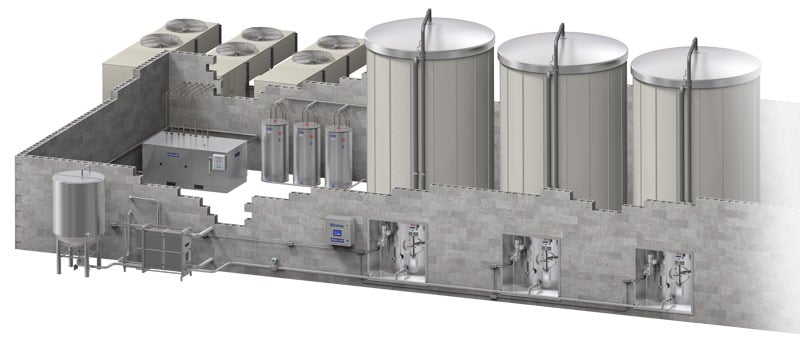When going through the process of purchasing a new milk-storage tank, one important consideration is whether to go with a horizontal or vertical tank. While the functionality and features of both options are the same, there are several factors that should drive your purchase decision. The following outlines the various benefits, differences, and considerations needed to help you make an informed decision.
The Differences Between Horizontal and Vertical Milk Tanks

A significant differentiator between a horizontal and vertical milk tank (also called a silo) has to do with placement. A horizontally oriented milk tank requires housing in an indoor space such as a tank room, whereas milk silos can be placed outdoors. There are some stipulations to outdoor silo storage—the agitator motor must be protected by a stainless steel cover, and elements such as the manhole, outlet, inlet, ventilation, and sampling valve have to be located inside a tank room. Therefore, for both horizontal and vertical scenarios, a tank room is a required part of the strategy.
Another notable difference is in the way the collection driver gathers the milk sample. In a horizontal tank, the driver will scoop the sample from the tank storage. In the silo tank, however, the sample is gathered via a sampling valve, which was developed as a result of contamination occurring when vertical tanks were initially engineered for outdoor use. A special sampling protocol was developed wherein the alcove becomes the connection between the tank and the milking parlor. The manhole, outlet, inlet, and sampling valve became accessible as a result.
Weigh the Benefits
The price point for a horizontal tank itself will almost always be less expensive than a comparable vertical silo tank. But once you consider other expenses—and depending on your site constraints—the horizontal tank may end up costing more in the long run. For instance, due to the need for a horizontal tank to be held in a sufficiently sized indoor tank room, the cost of constructing the building could potentially surpass the price difference between the horizontal and vertical tanks. However, when a viable existing tank room is available, the horizontal tank option would typically be lower cost than the vertical tank. If unit price alone is the distinguishing factor, the break-even point for Paul Mueller Company tanks lies at the 28,000-liter size.
The decision to go with a silo often comes down to space limitations, and for that reason, silos have become increasingly popular. When space is limited, the vertical orientation greatly increases placement options and farm-space usability. This can be a particularly important distinguishing factor in operations where major alterations to a farm aren’t possible, rendering land and space valuable assets. Consider this example: Suppose a typical tank room built to house a horizontal 18,000-liter Mueller PC-18000 with recommended specifications of 5.95 x 3.63 m measures 21.6 sq. m. Now suppose that the smaller tank room for the vertical silo option of the 18,000-liter Mueller PC-18000 measures only 17.75 sq. m. This totals 3.85 sq. m. of saved space by opting for the silo.
Whether horizontal or vertical tanks are best for your operation, maintaining an optimal cooling process is critical to ensuring high-quality milk storage. Toward that end, all Paul Mueller products are engineered for quality, reliability, and performance. That’s why Paul Mueller Company is a worldwide leader in the dairy farming industry and seeks to educate and inform dairy farm professionals, equipping them to understand the various options to identify the best for their unique operation. Contact us if you need help deciding what milk cooling solution is best for you and your farm.


